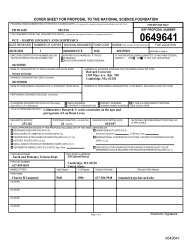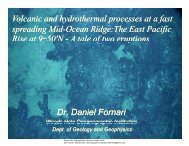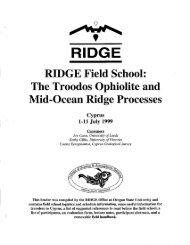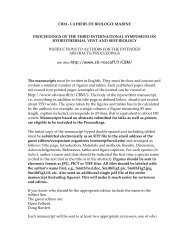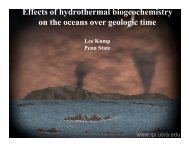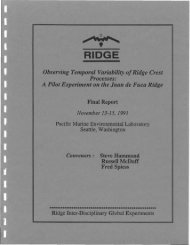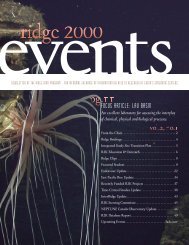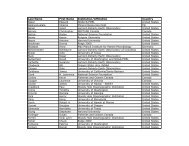Create successful ePaper yourself
Turn your PDF publications into a flip-book with our unique Google optimized e-Paper software.
Dispersal of Organisms<br />
What are the biological and physical characteristics<br />
responsible for the dispersal and life histories of organisms at<br />
deep-sea hydrothermal vents?<br />
A concerted effort must be devoted to defining the range of<br />
reproductive strategies encountered among vent species and to<br />
obtaining a detailed understanding of the reproductive responses<br />
of vent organisms to environmental signals. Vent spacing, ridge<br />
segmentation, offset distances, and interposing land masses may<br />
provide barriers to gene exchange allowing chance events and<br />
local selection to influence the genetic composition of populations<br />
and species. The role of chance events and natural selection<br />
in the development of vent ecosystems will be understood<br />
through study of dispersal stages and genetic differentiation of<br />
populations.<br />
Vent chemistry and fluctuations in vent flow need to be<br />
related to life history features such as rate of growth, time to<br />
maturity, reproduction and mortality, and selective survival of<br />
post-settlement stages. The influence of hydrothermal plume<br />
dynamics andI or physical currents (mesoscale eddies, along-ridge<br />
transport, etc.) on the transport of various life history stages<br />
of vent organisms needs intense study, as does the distribution<br />
of such stages within both the water column and the benthic<br />
boundary layer. To address these problems it is paramount to<br />
know the duration of vent activity.<br />
Necessary sampling and analytical approaches include in situ<br />
chemical characterization of hydrothermal systems, measurements<br />
of rates of tissue accretion and skeletal deteriorationl<br />
dissolution, in situ organism manipulations, and efficient<br />
sampling of the plankton. In addition it is necessary to<br />
undertake physical oceanographic measurements, settlement and<br />
colonization substrate experiments, interpretative analyses of<br />
larval morphological features, studies of mitochondrial DNA, and<br />
gel electrophoretic studies.<br />
Speciation and Evolution<br />
What is the role of geographic isolation in the evolution of<br />
vent communities on ocean ridges?<br />
Evolution of vent communities is a reflection of long-term<br />
geological processes governing ridge and hydrothermal evolution.<br />
Linear spacing of vents and the isolation of entire ridge<br />
systems results in evolutionary processes on several spatial<br />
scales: separation of populations and species, evolution of one<br />
species into another, introduction of new species to the vent<br />
habitat. and co-evolution of the community members.<br />
49 .




